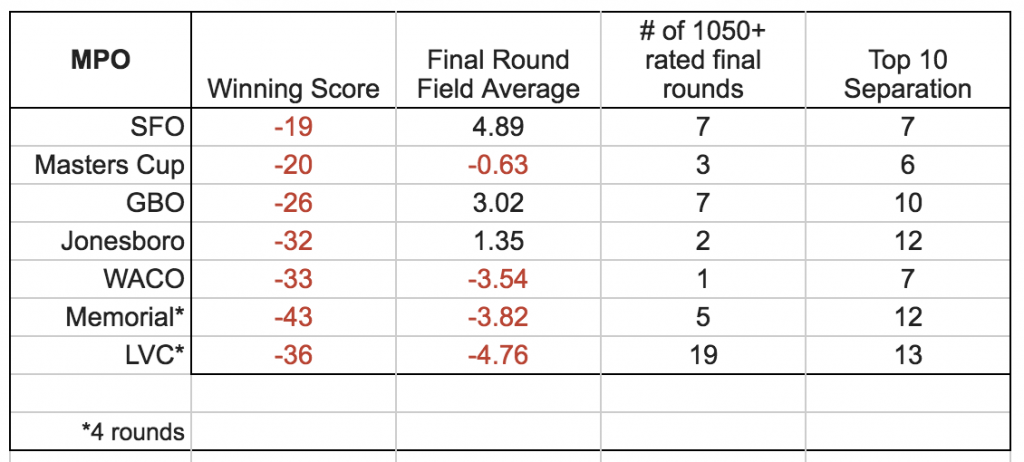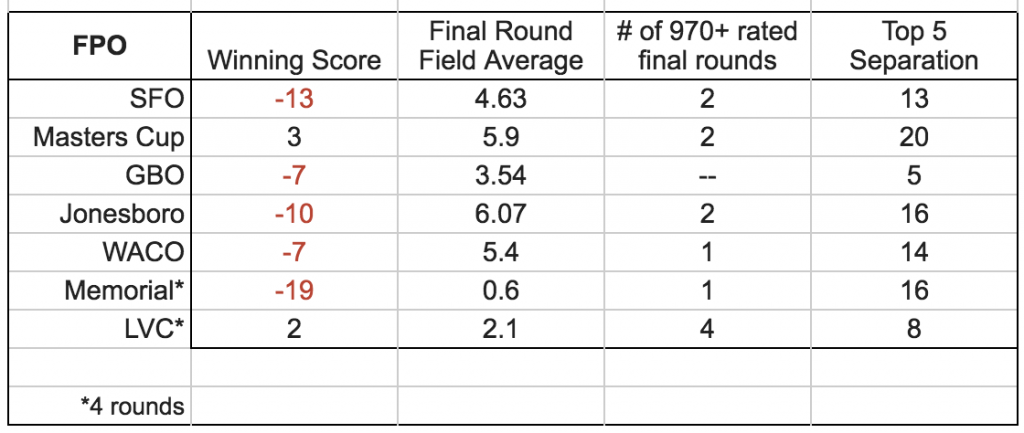How NT and DGPT final rounds have scored in 2018
June 7, 2018 by Bennett Wineka in Analysis with 0 comments
On the most recent Upshot, hosts Charlie Eisenhood and Jamie Thomas compiled and broke down early season PDGA National Tour and Disc Golf Pro Tour events by final round statistics to see if any patterns would emerge.

As you can see from the Open division statistics, overall winning scores at these events have drifted closer to par since the beginning of the season at the Las Vegas Challenge, generally corresponding with higher final round score averages. With the courses playing close to par, separation of the top ten finishes by strokes has also shrunk. With Las Vegas as the outlier, final rounds rated 1050 or higher don’t have any direct correlation to scores.

The Open Women fields in 2018 have so far had much more variability and do not exhibit any noticeable trends. Even comparing the same events to the Open division, the San Francisco Open, the closest score to par for an Open winning score, is the second lowest winning score in Open Women this year. Las Vegas also depicts an interesting scenario where the final round field average is the second lowest of the events and the most 970-rated rounds were recorded, but the overall winning score is second highest.
It’s hard to decide what factors in to these scores. Are players losing energy, getting worn down by the tour, so scores have gotten closer to par as the season progresses? Or do the most recent events and courses have more accurate par listings? Maybe it’s none of these and we’re overthinking this.
Here’s what it could mean for this weekend’s Beaver State Fling using the same analysis on the 2017 tournament results.
Starting on the Open side, last year’s winning score by Ricky Wysocki was 28-under par, not counting any strokes from the playoff victory. The top ten finishers were separated by a total of 12 strokes and zero final round ratings were 1050 or higher (only seven Open rounds were rated 1050+, all coming on the West course during rounds 1 or 3). Using these metrics, BSF compares most directly to the Glass Blown Open or Jonesboro Open, although if you factor in the fourth round played in Oregon, it may play closer to Masters Cup.
The last three Flings have had at least one division go to a playoff to decide a winner, don’t expect the top ten scoring separation to surpass the current season high of 13. Open will also be finishing on the East course again so final rounds rated 1050+ will be rare.
Last year’s Open Women’s results may be an aberration. Paige Pierce’s winning score of 2-under par included three 1000+ rated rounds putting her 18 strokes ahead of second place. It was 31 strokes separating first and fifth place. Like the Open field, there were zero 970+ rated rounds on the final day.
Using the second place score from last year and 2016’s winning Open Women’s score, expect this year’s BSF winning score to be a couple strokes over par, and the scoring separation from first to fifth to be around the 15 stroke mark. Again, the Open Women’s results may closely resemble Masters Cup.